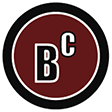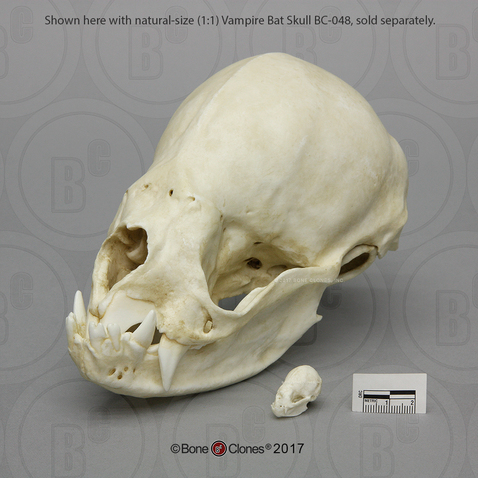-
Fields of Study
- K-12 Education
- Advanced Anatomy
- Forensics
- Physical Therapy
- Primate Locomotion
- Non-primate Locomotion
- Biological Anthropology
- Paleontology
- Bioarchaeology
- Marine-Aquarium
- Veterinary
-
Zoology
- All Zoological Items
- Endangered Species
- Skulls
- Skeletons
- Cranial Elements
- Postcranial Elements
- Eggs
- Limbs
- Teeth & Fangs
- Claws & Talons
- Brains & Endocasts
- Life Casts
- Pathology & Trauma
- Wildlife Forensics
- Sets
- Bird Sets
- Accessories
- Birds
- Mammals
- Reptiles & Amphibians
- Fish
- Sharks & Rays
- Turtles & Tortoises
- Anatomy for the Artist
- Decor
- Veterinary
- Elements
- Pathology & Trauma
-
Sets & Series
- Natural History Gift Ideas
- Decor
- Scale & Sculpture
- 3D Scanned & Printed
- Bone Boxes
- Locomotion Sets
- Forensic Sets
- Advanced Anatomy Sets
- Physical Therapy Series
- Fetal Sets
- Economy Series
- Zoology Sets
- Bird Sets
- Claw & Talon Sets
- Tooth & Fang Sets
- Primate Skull Sets
- Fossil Hominid Sets
- B.I.O.P.S.I. - Babiarz Institute
- Maxwell Collection
- Bergdorf Goodman Windows
- Accessories
- New Products
-
Our Company
- News & Specials
- Printable Handouts
- About Us
- Why Choose Bone Clones
- Bone Clones in the News
- Mission
- Contact Us
- Privacy and Security
- Frequently Asked Questions
- Testimonials
- Community Outreach
- Legal/Copyright
- Flyers
- Choosing Original Specimens
- Museum Exhibitions
- Natural History Gift Ideas
- About the Economy Series
- Acknowledgements
- Ordering & Delivery
- Warranty
- Refund/Return Policy
- Price List at a Glance
- Our Catalog
- Osteological Evaluation Reports
- About 3D Printing
- Sawyer & Maley Neanderthal Reconstruction
- Site Introduction
- Newsletter Archive
-
Human Anatomy
- All Human Anatomy
- Human Skulls
- Human Skeletons
- Head & Neck
- Postcranial Elements
- Advanced Anatomy
- Physical Therapy / Joints
- Human Brains & Endocast
- Human Life Casts
- Maxwell Museum
- Sets & Series
- Accessories
- Osteological Evaluation Reports
- Featured
- Adult Human Anatomy
- Adolescent Human Anatomy
- Child Human Anatomy
- Fetal Human Anatomy
- Fossil Hominids
-
Zoology
- All Zoological Items
- Endangered Species
- Skulls
- Skeletons
- Cranial Elements
- Postcranial Elements
- Eggs
- Limbs
- Teeth & Fangs
- Claws & Talons
- Brains & Endocasts
- Life Casts
- Pathology & Trauma
- Wildlife Forensics
- Sets
- Bird Sets
- Accessories
- Birds
- Mammals
- Reptiles & Amphibians
- Fish
- Sharks & Rays
- Turtles & Tortoises
- Paleontology
- Non-human Primates
- Forensics
All items sold on this website are replicas and are 1:1 scale unless stated otherwise. All Bone Clones® products are made in the USA. No real/natural bone is available on this site.
 ALSO SEE:
ALSO SEE:
Vampire Bat Skull, 8:1 Scale
TSBC-333 $223.00
The majority of Bone Clones® are created by making molds of original bone material. In limited instances to change scale from smaller or larger, we employ 3D scanning of the original and printing technology, hand detail the printed version to match the original specimen, and then use it to make our product mold.
The vampire bat (Desmodus rotundus) is a small bat, 2.5 to 3.5 inches in length with a wingspan of about 8 inches. The minute size of the vampire bat skull makes it a challenge to study its delicate cranial structures. Here, we increased the size of the scan 8 times then printed the enlarged skull, allowing for detailed study of the teeth and unique ear morphology that make bat echolocation (sonar) possible. To retain detail, the bullae (ear bones) were separately scanned, printed and assembled in the skull.
Weighing between 1 to 2 ounces, the vampire bat can consume 60% of their body weight in blood. Vampire bats have strong, well-developed hind legs, which affords them speed and agility on the ground. Their canine teeth are adapted for cutting hair and their large triangular incisors are highly modified to serve as sharp lancets to get the blood meal flowing freely. Animals that eat blood are called sanguivores, and the act of eating blood is called hemophagy. Their grooved and hairless nose contains infrared heat sensors to help them locate areas of rich blood flow closest to the skin surface of their victims. They have anticoagulant-rich saliva and a long, grooved tongue to aid their efforts. They only range in tropical rainforests from Mexico to Argentina and Chile and are also found on the islands of Trinidad and Margarita off the Venezuelan coast.
2-part skull (separate cranium & jaw).
More About How Bone Clones Uses 3D Printing and Scanning
| Scientific Name | Catalogue # | Size | Price |
| Desmodus rotundus | TSBC-333 | 7 ½" L x 4" W x 4 ¾" H 19.3L x 9.9W x 12H (cm) | $223.00 |
Related Products:
-
 Common Vampire Bat Skull
Common Vampire Bat Skull -
 Cave Myotis Bat Skull, 8:1 Scale
Cave Myotis Bat Skull, 8:1 Scale -
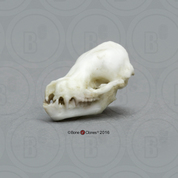 Cave Myotis Bat Skull
Cave Myotis Bat Skull -
 Black-footed Ferret Skull
Black-footed Ferret Skull -
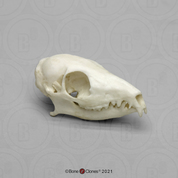 Tree Shrew Skull
Tree Shrew Skull -
 Hyacinth Macaw Skull
Hyacinth Macaw Skull -
 Harpy Eagle Skull
Harpy Eagle Skull -
 Gila Monster Skull
Gila Monster Skull -
 Common American Beaver Skull
Common American Beaver Skull -
 Coyote Skull
Coyote Skull -
 Greater Flying Fox Skull
Greater Flying Fox Skull -
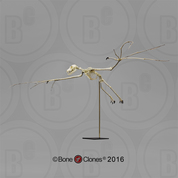 Greater Flying Fox Skeleton, Articulated
Greater Flying Fox Skeleton, Articulated -
 Articulated Fruit Bat Wing
Articulated Fruit Bat Wing -
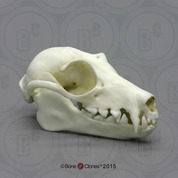 Fruit Bat Skull
Fruit Bat Skull -
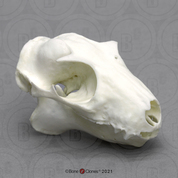 Colugo, Flying Lemur Skull
Colugo, Flying Lemur Skull
Newsletter Signup
9200 Eton Ave.
Chatsworth, CA 91311 USA
© 1992-2025 Bone Clones Holdings. All Rights Reserved.
Customer Service
© 2025 BONE CLONES HOLDINGS / Made by MEV


